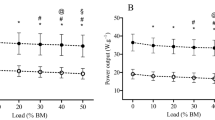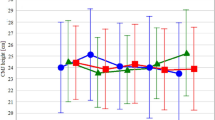Abstract
Purpose
To investigate the selective effects of different types of external loads applied in vertical jump training on both the performance and muscle power output of the squat (SJ) and countermovement jump (CMJ).
Methods
Physically active males practiced maximum unconstrained vertical jumps over an 8-week period with no load, with either a negative or positive load exerted by a nearly constant external force that altered their body weight, and with a loaded vest that increased both the body weight and inertia. The magnitude of all applied loads corresponded to 30 % of body weight.
Results
A similar training-associated increase in jump height was observed in all experimental groups in both CMJ (7.4–11.8 %) and SJ (6.4–14.1 %). The relative increase in power output was comparable to the increase in jump height in SJ (7.4–11.5 %), while the power increase in CMJ was relatively small and load-specific (0.5–9.5 %). The observed differences could originate from the changes in the CMJ pattern, reflected through the depth of the counter movement that particularly increased after the training with negative load (42 %) and no load (21 %). The same participants also revealed increased CMJ duration, reduced ground reaction forces, as well as reduced maximum and average power output when compared with other training groups.
Conclusion
Jump training with the applied loads could lead to a comparable improvement in jumping performance. However, the observed load-specific adaptations of CMJ pattern could decouple the training-associated increase in jump height from the increase in muscle power output.




Similar content being viewed by others
Abbreviations
- CMJ:
-
Countermovement jump
- ConG:
-
Control group
- ES:
-
Effect size
- F max :
-
Maximum GRF
- F tran :
-
GRF in the instant of transition from the eccentric to concentric jump phase
- GRF:
-
Ground reaction force
- ΔHecc :
-
Depth of the counter movement
- H max :
-
Maximum jump height
- NegLG:
-
Negative load group
- NoLG:
-
No-load group
- P avg :
-
Average power during the concentric jump phase
- P max :
-
Peak power
- PosLG:
-
Positive load group
- SJ:
-
Squat jump
- t con :
-
Duration of the concentric jump phase
- t ecc :
-
Duration of the eccentric jump phase
References
Anderson CE, Sforzo GA, Sigg JA (2008) The effects of combining elastic and free weight resistance on strength and power in athletes. J Strength Cond Res 22(2):567–574
Argus CK, Gill ND, Keogh JW, Blazevich AJ, Hopkins WG (2011) Kinetic and training comparisons between assisted, resisted, and free countermovement jumps. J Strength Cond Res 25(8):2219–2227
Baker D, Nance S, Moore M (2001) The load that maximizes the average mechanical power output during jump squats in power-trained athletes. J Strength Cond Res 15(1):92–97
Bobbert MF (2012) Why is the force-velocity relationship in leg press tasks quasi-linear rather than hyperbolic? J Appl Physiol 112(12):1975–1983
Cormie P, McGuigan MR, Newton RU (2010a) Adaptations in athletic performance after ballistic power versus strength training. Med Sci Sports Exerc 42(8):1582–1598
Cormie P, McGuigan MR, Newton RU (2010b) Changes in the eccentric phase contribute to improved stretch-shorten cycle performance after training. Med Sci Sports Exerc 42(9):1731–1744
Cormie P, McGuigan MR, Newton RU (2010c) Influence of strength on magnitude and mechanisms of adaptation to power training. Med Sci Sports Exerc 42(8):1566–1581
Cormie P, McGuigan MR, Newton RU (2011) Developing maximal neuromuscular power: part 2–training considerations for improving maximal power production. Sports Med 41(2):125–146
Cronin J, Sleivert G (2005) Challenges in understanding the influence of maximal power training on improving athletic performance. Sports Med 35(3):213–234
Domire ZJ, Challis JH (2007) The influence of squat depth on maximal vertical jump performance. J Sports Sci 25(2):193–200
Gavrilovic P, Ristanovic D, Jaric S (1981) “In vivo” study on the effect of muscle length on its maximum force of contraction. Periodicum Biologorum 83:135–137
Harman EA, Posenstein MT, Frykman PN, Rosenstein RM, Kraemer WJ (1991) Estimation of human power output from vertical jump. J Appl Sport Sci Res 5(3):116–120
Harris GR, Stone MH, O’Bryant HS, Proulx CM, Johnson RL (2000) Short-term performance effects on high power, high force, or combined weight-training methods. J Strength Cond Res 14(1):14–20
Harris NK, Cronin JB, Hopkins WG, Hansen KT (2008) Squat jump training at maximal power loads vs. heavy loads: effect on sprint ability. J Strength Cond Res 22(6):1742–1749
Holcomb WR, Lander JE, Rutland RM, Wilson GD (1996) The effectiveness of a modified plyometric program on power and the vertical jump. J Strength Cond Res 10(2):89–92
Israetel MA, McBride JM, Nuzzo JL, Skinner JW, Dayne AM (2010) Kinetic and kinematic differences between squats performed with and without elastic bands. J Strength Cond Res 24(1):190–194
Jaric S, Markovic G (2009) Leg muscles design: the maximum dynamic output hypothesis. Med Sci Sports Exerc 41(4):780–787
Kaneko M, Fuchimoto T, Toji H, Suei K (1983) Training effect of different loads on the force–velocity relationship and mechanical power output in human muscle. Scand J Med Sci Sports 5(2):50–55
Leontijevic B, Pazin N, Bozic PR, Kukolj M, Ugarkovic D, Jaric S (2012) Effects of loading on maximum vertical jumps: selective effects of weight and inertia. J Electromyogr Kinesiol 22(2):286–293
Leontijevic B, Pazin N, Kukolj M, Ugarkovic D, Jaric S (2013) Selective effects of weight and inertia on maximum lifting. Int J Sports Med 34(3):232–238
Lyttle AD, Wilson GJ, Ostrowski KJ (1996) Enhancing performance: maximal power versus combined weights and plyometrics training. J Strength Cond Res 10:173–179
Markovic G (2007) Does plyometric training improve vertical jump height? A meta-analytical review. Br J Sports Med 41(6):349–355 (discussion 355)
Markovic G, Jaric S (2005) Scaling of muscle power to body size: the effect of stretch-shortening cycle. Eur J Appl Physiol 95(1):11–19
Markovic G, Jaric S (2007a) Is vertical jump height a body size-independent measure of muscle power? J Sports Sci 25(12):1355–1363
Markovic G, Jaric S (2007b) Positive and negative loading and mechanical output in maximum vertical jumping. Med Sci Sports Exerc 39(10):1757–1764
Markovic G, Dizdar D, Jukic I, Cardinale M (2004) Reliability and factorial validity of squat and countermovement jump tests. J Strength Cond Res 18(3):551–555
Markovic G, Vuk S, Jaric S (2011) Effects of jump training with negative versus positive loading on jumping mechanics. Int J Sports Med 32(5):365–372
Matavulj D, Kukolj M, Ugarkovic D, Tihanyi J, Jaric S (2001) Effects of plyometric training on jumping performance in junior basketball players. J Sports Med Phys Fit 41(2):159–164
McBride JM, Triplett-McBride T, Davie A, Newton RU (1999) A comparison of strength and power characteristics between power lifters, olympic lifters, and sprinters. J Strength Cond Res 13(1):58–66
McBride JM, Triplett-McBride T, Davie A, Newton RU (2002) The effect of heavy- vs. light-load jump squats on the development of strength, power, and speed. J Strength Cond Res 16(1):75–82
Nedeljkovic A, Mirkov DM, Markovic S, Jaric S (2009) Tests of muscle power output assess rapid movement performance when normalized for body size. J Strength Cond Res 23(5):1593–1605
Newton RU, Murphy AJ, Humphries BJ, Wilson GJ, Kraemer WJ, Hakkinen K (1997) Influence of load and stretch shortening cycle on the kinematics, kinetics and muscle activation that occurs during explosive upper-body movements. Eur J Appl Physiol Occup Physiol 75(4):333–342
Newton RU, Rogers RA, Volek JS, Hakkinen K, Kraemer WJ (2006) Four weeks of optimal load ballistic resistance training at the end of season attenuates declining jump performance of women volleyball players. J Strength Cond Res 20(4):955–961
Nuzzo JL, McBride JM, Dayne AM, Israetel MA, Dumke CL, Triplett NT (2010) Testing of the maximal dynamic output hypothesis in trained and untrained subjects. J Strength Cond Res 24(5):1269–1276
Pazin N, Berjan B, Nedeljkovic A, Markovic G, Jaric S (2013) Power output in vertical jumps: does optimum loading depend on activity profiles? Eur J Appl Physiol 113(3):577–589
Selbie WS, Caldwell GE (1996) A simulation study of vertical jumping from different starting postures. J Biomech 29(9):1137–1146
Sheppard JM, Dingley AA, Janssen I, Spratford W, Chapman DW, Newton RU (2011) The effect of assisted jumping on vertical jump height in high-performance volleyball players. J Sci Med Sport 14(1):85–89
Swinton PA, Stewart AD, Lloyd R, Agouris I, Keogh JW (2012) Effect of load positioning on the kinematics and kinetics of weighted vertical jumps. J Strength Cond Res 26(4):906–913
Wallace BJ, Winchester JB, McGuigan MR (2006) Effects of elastic bands on force and power characteristics during the back squat exercise. J Strength Cond Res 20(2):268–272
Acknowledgments
The study was supported in part by Grant from the US National Institute of Health (R21AR06065) and Grants from Serbian Research Council (175037 and 175012).
Conflict of interest
Authors claim no conflict of interest.
Author information
Authors and Affiliations
Corresponding author
Additional information
Communicated by William J. Kraemer.
Rights and permissions
About this article
Cite this article
Markovic, S., Mirkov, D.M., Knezevic, O.M. et al. Jump training with different loads: effects on jumping performance and power output. Eur J Appl Physiol 113, 2511–2521 (2013). https://doi.org/10.1007/s00421-013-2688-6
Received:
Accepted:
Published:
Issue Date:
DOI: https://doi.org/10.1007/s00421-013-2688-6




